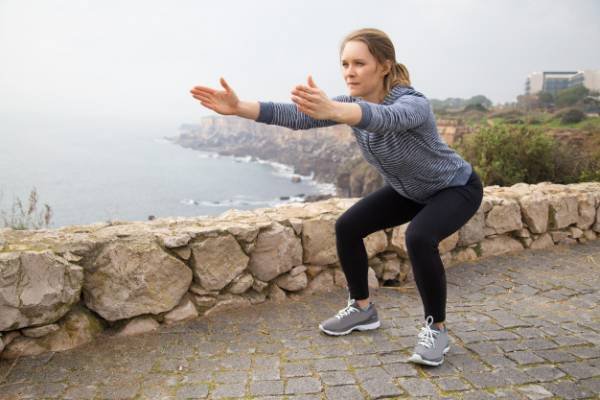SquatWhat is it?
Squats, or squat exercises, are movements performed in bodybuilding and fitness.FitnessThey target the quadriceps muscles and strengthen the back muscles, glutes, core, and hamstrings.
Squats are a fundamental exercise in weightlifting that can enhance speed, jumping height, and athletic abilities, while also strengthening bones.

Muscles involved in squats
Squats are a compound movement that engages the entire body and significantly affects muscle performance. Squats strengthen the quadriceps, front thigh, hamstrings, and core muscles that bend the knees, propelling you forward during running.RunningThis strengthening of muscles helps prevent runners from experiencing problems and
knee painSquats are essential for increasing the size of thighs, glutes, and overall muscle strength.Main muscles
Gluteus maximus, quadriceps, hamstrings
Secondary muscles
Transverse abdominis, gluteus medius/minimus, gastrocnemius
Benefits of squats for the body

Squats are the best stimulant
for growth hormoneSquat training is one of the best leg exercises that stimulates the release of anabolic hormones like testosterone and growth hormone. This exercise is considered a total body strength workout that engages most of your muscles.
Include such exercises in your routine because you will definitely need the anabolic hormones released during
muscle buildingTo promote the release of anabolic hormones, correctly perform squats daily.Strengthening lower body muscles

Squats can activate a wide range of lower body muscle groups to maintain balance and engage secondary muscles during movement.
Increasing core strength
Squats engage all body muscles, requiring you to contract every muscle while performing the exercise. This contraction helps prevent injuries, maintain spinal alignment, and increases core strength. The motion starts from the upper body and moves downward.
Performing squats allows your upper and lower body to coordinate, also strengthening the core area. This combined and strength training is beneficial for those seeking to strengthen muscles and achieve a six-pack.
Increasing flexibility

Squat exercises not only strengthen muscles and enhance power but also improve flexibility. The wide movement of squats creates pressure in the pelvic area, making it more flexible and thereby reducing the risk of strains and pains in those regions.
Weight loss
andfat burningSquats engage your body muscles, increasing your heart rate
and boosting your metabolism. This exercise is very effective for both fat burning and muscle building.Increasing jumping and pulling powerSquats, by strengthening the thigh and calf muscles, enhance jumping and pulling strength, making a significant impact on strength and power. Improved pulling strength can reduce injuries during bodybuilding.

Strengthening knee and hip muscles
The cause of chronic pain in the knee and hip joints for some individuals is weak muscles in these areas, resulting in increased pressure on joints during daily activities and intense sports, leading to injuries and pain. Squat exercises can effectively strengthen muscles in these areas and reduce chronic pain.
Other benefits of squat exercises for the body
Improving body posture

The best movement for warming up
- Reducing
- cellulite
- Increasing body movementTypes of squats
- Side squats
Rotational squats
- Overhead squats
- Jump squats
- Two-phase squats
- How to perform a squat
- 1. To perform this exercise

wear appropriate shoes
and stand on a flat, non-slippery surface.2. Stand with your feet shoulder-width apart.3. You can use dumbbells or barbells as well, but using them depends on your fitness level and strength.
4. Cross your arms over your chest or extend them straight in front of you.
5. Slowly bend your knees and try to sit back into your heels.
6. The lower you go, the more pressure there will be from the exercise; how low you can go depends on your ability.
7. During the movement, keep your weight on your heels so you can easily lift your toes off the ground.
8. If performed correctly, your thigh muscles will feel a burn during the exercise.

9. After a few seconds, return to a standing position.
10. Perform this move as many times as necessary to strengthen your muscles.
11. Maintain your natural back position and avoid letting your knees extend too far forward.
12. When performing this exercise, do not allow your back to arch; sit low enough so your thighs are parallel to the ground.
13. If you don’t have flexible ankles, you will find yourself leaning more at the back, putting excessive strain on your spinal muscles, which will lead to soreness after the workout.
Essential tips for executing squats
You may use a special weight training belt and knee wraps for this exercise.

Gradually increase weights according to your ability, as performing squats with heavy weights increases the risk of injury and can lead to improper form.
- Ask your trainer to teach you the correct technique before you start exercising and ensure you have the necessary training.
- Individuals who should avoid performing squats
- Those with joint issues in the knees, ankles, spine, or
herniated discs
should consult with their doctor before attempting this exercise, as the doctor may advise against it.Beginners should not add this exercise to their routine without consulting a trainer first and should ensure they receive proper training before attempting.Tall individuals or those with longer lower bodies compared to their upper bodies should refrain from this exercise because of the height of their center of gravity from the ground. The best suggestion for tall individuals to maximize the benefits of squats is box squats, which alleviate excessive pressure on the spine and knees.
Rest the barbell on your shoulder muscles and carefully sit down on the bench while maintaining control, then rise again. This way, you will protect your knee and spinal health. Remember to exercise in the safest and healthiest way possible.

Those who perform this exercise incorrectly can harm their spine and knees, but if done properly, it does not place additional strain on these joints.
Who can perform squats better?
Individuals of average or shorter height can perform squats more effectively.
People with higher body resistance can perform squats better.
- Do not do squats every day
- Not everyone can perform squats daily. People with lower body strength may not be able to do this regularly and may experience

muscle cramps
- in their legs.If you feel that doing squats every day is too much pressure for you, do them every other day. For example, perform squat exercises 2 to 3 times a week, allowing 48 hours between each session to give your body time to recover.During this exercise, pay attention to your diet and ensure you consume enough protein.
- Types of squat movements
- Reasons why squats are essential







